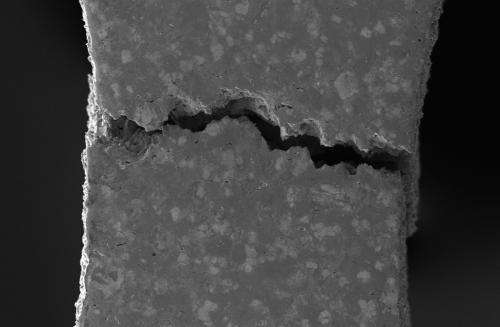New method to understand steel fracturing

Researchers from the Universidad Carlos III de Madrid (UC3M) have visualized step-by-step and on a microscopic level how certain steels fracture when extreme loads are applied to them. This could help to improve these materials, which are used in the automobile industry.
Scientists from the UC3M Powder Technology Group (initialled GTP in Spanish) have carried out this research using a scanning electron microscope to obtain high-resolution images (around 10 nanometers; a nanometer is one millionth of a millimeter). The application of new techniques to characterize materials has made it possible to better understand the behavior of sintered steels (those produced from powders) on fracturing. In this way, they have been able to discover where the first cracks "'nucleate' and where they particularly extend to," the GTP researchers explain.
The materials that are the subject of the research are commercial sintered steels obtained through powder metallurgy or powder technology and are widely used in the automobile industry. Mechanical and on-site characterization tests performed in the scanning electron microscope have been essential in "understanding the mechanisms of fracture," which, until this research, "we have never been able to determine, but instead only intuit," explains one of the authors of the study, Elena Bernardo, from the UC3M Powder Technology Group.
In this study, published in the journal Powder Metallurgy, several steels currently on the market were evaluated. Specifically, an Fe-C steel, a steel pre-alloyed with molybdenum (Astaloy Mo grade, Höganäs AB) and the well-known Distaloy AE (Höganäs AB), which is iron alloyed by diffusion with copper, nickel and molybdenum, were analyzed. The results have helped in understanding the connection between microstructure and properties, which in these materials entails a technological challenge, as not only the phases but also the residual porosity that composes their microstructure come into play. José Manuel Torralba, full professor in the UC3M department of Materials Science and Engineering and Deputy Director of the IMDEA Materials Institute, stresses the fundamental role of porosity in these steels: "The research has revealed, among other things, that the most angular and irregular pores are the first points of 'nucleation,' that is, those that initiate the breaking."
This study has made it possible to fulfill the "dream" of any scientist devoted to Materials Science and Engineering, as it makes changes in the microstructure of the material visible while it is being tested, says Torralba. Moreover, the methodology used "is applicable to any type of alloy" and not only to test its behavior under pressure, but "also its behavior at high temperatures." Some of the research was carried out at the UC3M facilities and was completed at IMDEA Materials, a research institute financed by the regional government of Madrid and the European Union.
More information: J. M. Torralba, L. Esteban, E. Bernardo, M. Campos. Understanding contribution of microstructure to fracture behaviour of sintered steels. Powder Metallurgy 2014; 57(5), 357-364. DOI: 10.1179/1743290114Y.0000000119
Provided by Carlos III University of Madrid




















